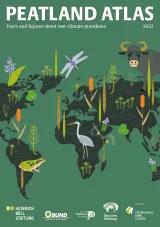
Because they take up greenhouse gases, peatlands cool the climate – but only as long as they are intact. But these peat-covered areas have been – and still are being – drained for agriculture, forestry, peat extraction and human settlement, exacerbating global warming.

Over thousands of years, peatlands have accumulated thick layers of peat – remains of dead plants, under permanent-wet soil conditions. In the oxygen-free environment under water, the plant remains decay only very slowly and are conserved, similar to pickled gherkins. The main component of peat is carbon. Peatlands cover only 3 percent of the Earth’s land surface but store in their peat a disproportionate quantity of carbon, around 600 billion tonnes. That is around twice the carbon stored in the biomass of all the Earth’s forests on 27 percent of the world’s land.
When they were alive, the plants that now make up the peat took the carbon out of the atmosphere as the greenhouse gas carbon dioxide (CO₂) and changed it by photosynthesis into plant material. As long as the peatland remains wet, the carbon stays largely in the peat. A small part of the carbon is, however, emitted as methane (CH₄), a powerful greenhouse gas. Wet peatlands emit around 30 million tonnes of methane per year – about one-third of the global emissions from livestock and manure. However, this emission does not burden the climate, because in the atmosphere methane quickly reacts with oxygen, changes into the weaker greenhouse gas CO₂, and thus loses its strong climate effect. Methane emissions raise the methane concentrations in the atmosphere only when the peatland starts to form.
Afterwards the methane concentrations do not keep rising – even with continuous emissions – but soon reach a steady state. The same amount of methane is broken down as is simultaneously emitted. On the other hand, the ongoing sink for CO₂ that natural peatlands represent continuously reduces the CO₂ concentration in the atmosphere. In this way, peatlands have lowered the average global temperature over the last 10,000 years by about 0.6 degrees Celsius.
Globally, around 88 percent of the world’s peatlands are still in a largely natural state. But more than 50 million hectares of peatlands have been drained so strongly that no new peat is formed any longer. On the contrary, the penetration of oxygen into the drained peat soil results in its continuous decomposition. That produces CO₂ and nitrous oxide (N₂O). The global warming effect of various greenhouse gases is expressed in terms of CO₂-equivalents. In Central European peatlands, a drop of the average water table of 10 centimetres results in an extra 5 tonnes CO₂-equivalent of emissions per hectare per year. In the tropics, the figure is as high as 9 tonnes.
Every year, drained peatlands emit almost 2 billion tonnes CO₂-equivalent, which is twice as much as the whole of global aviation. Almost 90 percent of these emissions consists of CO₂, the rest of methane and nitrous oxide. On top of that are the emissions from peat fires. Peat fire emissions vary considerably over time and are difficult to measure – but on average they may amount to between 500 million and a billion tonnes of CO₂-equivalent a year. Apart from emitting greenhouse gases, peat fires also produce dangerous levels of air pollution, which can spread far beyond its region of origin. According to studies, more than 100,000 people have died as a result of large peat fires in Indonesia in 2015. Over half a million people had acute respiratory problems; the national economic damage is estimated at up to 40 billion euros.
Although drained peatlands make up less than half a percent of the Earth’s land area, they are responsible for around 5 percent of all human-induced emissions – peat fire emissions included. Most peatland emissions come from Indonesia, the European Union (EU) and Russia. Within the European Union, half of the emissions come from Germany, Finland and Poland. By far the biggest share of these emissions originates from drained agricultural land.
Without effective policy countermeasures, emissions from drained peatlands could by the end of the century use up over 40 percent of the greenhouse gas budget remaining to keep global warming below 1.5 degrees Celsius. To comply with the goals of the Paris Climate Agreement, net CO₂ emissions must be reduced to zero by 2050. Experts have pointed out that this goal can be achieved only through the immediate and complete rewetting of all drained peatland. That means that globally 50 million hectares of peatland must be rewetted. In the EU, that means 500,000 hectares each year – and worldwide 2 million hectares.


